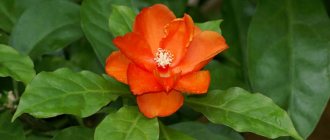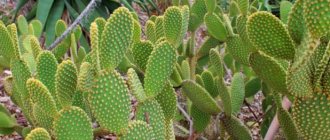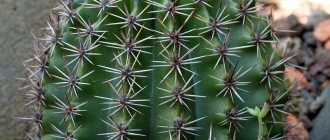A cactus is a succulent plant. It actively accumulates moisture obtained from soil and air. It is always in demand among amateur flower growers. This plant variety is striking in its appearance. At its base there is a thick fleshy stem and an unusual arrangement of leaf blades. Some species do not have leaves; they are replaced by sharp thorns in the form of thin spines.
They actively participate in the process of photosynthesis. In addition, additional moisture comes from the air through the spines. In nature, there are more than a hundred species and names of cacti. Each variety has its own characteristics and a specific flowering period.
How to determine the type of cactus? What criteria ensure active growth and constant vegetation of this crop? The answer to these questions is presented in our article. Advice from experienced professionals will help you avoid common mistakes in the process of growing tropical crops.
History of appearance
For now, one can only guess about the true origin of this culture, since not a single reliable fact has been found so far.
However, scientists suggest that the cactus family is quite ancient. They are believed to have appeared more than 30 million years ago. Their fossil remains have never been discovered, but the rock paintings have been preserved. From them we can judge that the homeland of cacti is the eastern part of India and some areas of South America. On the bas-reliefs of the ancient Aztecs you can see drawings reminiscent of these plants. They closely resemble modern varieties of cacti.
Most likely, their ancestors were rather moisture-loving crops with well-developed leaf blades, but developing in a hot climate, they had to adapt to environmental conditions. This is how new forms of plants appeared. Perhaps these include succulents.
Cacti got their name from the Greek word “kaktos”. This is how all unknown plants used to be called.
In scientific literature, culture was first mentioned in one of the works of a scientist named Tabernemontan in the 16th century. He worked on the characteristics of cacti. Further, in the 18th century, the term “cactus” was firmly attached to this plant, thanks to Carl Linnaeus. It began to mean all types of plants that have thorns.
Spread to Europe
Cacti are well known to residents of Mexico and the American states of Texas, New Mexico, and Arizona. Many varieties of bizarre shapes and sizes grow in the Andean mountains, Sri Lanka, India, Madagascar and China.
Having appeared in European countries, the cactus became an unusual discovery for its inhabitants. It is known that already at the beginning of the 19th century, some Europeans could boast of their rich collection of this plant, which was popular.
In Russia, the cactus first appeared in St. Petersburg. It was brought from hot countries for the purpose of sale. With the creation of the Apothecary Garden in 1714, exotic plants began to appear, including different varieties of cacti.
These days, cacti are no less popular. New species appear thanks to the efforts of breeders. The Dutch were especially successful in this, creating unique varieties, including those without thorns. Prickly pear cacti are very popular because they quickly adapt to the environment. In the wild they are common in Crimea. Despite the fact that many varieties have long grown in the desert, they now feel great at home in decorative pots.
Cacti serve as raw materials for the production of some food products, alcoholic beverages, cosmetics and medicines. In ancient times, the plant was also actively used for medicinal purposes, for example, to stitch up skin wounds with needles.
Arrangement of flowers in cacti
In Coryphantas, Telocacti, Parodies, Notocacti, Acanthocalyciums, Wigginsias, Waingartias and some other cacti, the flowers have a short tube or are slightly raised above a thick cushion of fluff or a “vase” of bunches of spines. Such flowers are often located in the area of the growing point on the top of the cactus. In adulthood, the cactus can be decorated with a whole bouquet of flowers (Parodia aureilanata). In the collection, it is better to place pots with similar species close to each other to create the impression of a flowering meadow.
The flowers of Echinocereus, Lobivia, Rebutia, Ailostera and some other cacti look like gramophones. An elongated tube covered with woolly spines or scaly outgrowths makes them even more exotic. Such flowers develop on the side of the cactus, in the area that has formed and matured in previous seasons. So that the flowers do not rest against neighboring plants and for a good view, it is better to place the pots not close to each other or at the edge of the tray.
Mammillaria and related species ( porphyria, mammilopsis, bartschella ) are distinguished by their original arrangement of flowers Their numerous flowers, and later bright fruits, form even wreaths along the “shoulders” of the cactus (Bartschella schumannii, Mammillaria chionocephala). In melocacti, such wreaths look out from a special organ on the top of these cacti - cephalium , reminiscent of a felt fez (Melocactus bahiensis). In discocacti, flowers appear in bouquets from the center of the cephalium.
Biological description
An unusual root system is extremely important for the cactus, which is a taproot system, but at the same time both the main root and lateral processes perform their functions well. In some species of cacti, the main part of the root thickens over time and becomes a storage organ. It makes the most of scarce precipitation or condensed moisture. It is known that the root system of a plant can change depending on conditions.
Cactus stems come in different shapes and sizes. The leaf primordia in most varieties do not form into leaf blades, but grow in the form of small tubercles. In a number of cacti they transform into ribs. Their function is to give strength to the plant, increase in size with a significant supply of moisture during precipitation. The stem can be green, gray, or blue.
Many varieties of cacti do not lack a leaf plate. As a rule, it is dense and fleshy. In some species it reaches a length of more than 25 cm, with a thickness of 6 cm. In severe drought, the leaves fall off.
Many varieties and varieties of cacti do not have spines, but at the stage of plant development, in the areoles, they are visible. They are often used for identification and to determine whether a culture belongs to a particular species. The spines vary in size, shape and color.
The areoles of cacti contain not only spines. They are divided into two parts. In one of them spines are formed, and in the other - a future flower or shoot. Each areole produces one flower and only in exceptional cases two or more.
The size of the flowers is varied - from 6 mm to 40 cm. Only some species have full inflorescences. Most cacti have axillary, solitary flowers. Those that bloom in the daytime have predominant shades: red, yellow, orange, and rarely green. Those specimens that bloom at night are white.
How different types of cacti adapt to living conditions
Cacti are perennial succulents. They are very light-loving, and during their historical development they have adapted to high temperatures and lack of water. This is possible due to the increased viscosity of the plasma and the high water content in the plant structure. The structure allows it to retain moisture and evaporate it in small quantities. They owe this to the dense layer of the epidermis and cuticle. The spines protect from excessive overheating; the ribs and papillae also act as a kind of shadow, blocking the stem from the sun. All this allows cacti to survive for a long period without moisture in the hot sun.
When growing domestic species of cacti, you must not miss the moment when the plant will need to be transplanted into a larger container. This is necessary for a young culture that is gradually increasing in size.
Classification of cacti according to group characteristics
All representatives can be divided into three groups:
- Pereskiaceae;
- Opuntiaceae;
- Cereus.
These types differ in structure. Thus, Pereskieves have round stems and flat leaves that are covered with straight spines. They often bloom with single flowers. It is distinguished by edible fruits.
Opuntia cacti are distinguished by small leaves covered with spines. In addition to spines, they also have glochidia. Glochidia are modified leaves of a plant. Large flowering. The colors are varied. The fruits are in most cases edible.
Cereus species lack leaves and glochidia. This is the largest family, which includes various species. Some representatives have edible fruits. Basically, Cereus cacti prefer arid areas.
Types of cacti
It is extremely difficult to systematize cacti, since there are so many varieties. They can be divided according to different characteristics and characteristics. For example, by shape, needles, colors, sizes, cacti are also distinguished between those grown at home and those growing in the wild.
Classification of cacti from a biological point of view implies the division of all representatives (more than 5000 items) into 4 subfamilies according to the following stable characteristics:
- form;
- color;
- the structure of the ovaries;
- location of flowers on the stem;
- characteristics of fruits and seeds.
Each of the four subgroups has its own characteristics and characteristics.
Family classification
The subgroups have the following names:
- Pereskiaceae;
- cactus;
- mauchiaceae;
- Opuntiaceae.
The largest subgroup is cacti. It contains plants with a wide habitat - forest zones, desert areas, as well as home conditions. There are a lot of varieties in this group and they all differ significantly from each other in shape, size, and a number of other characteristics. Cacti that grow in deserts are overgrown with long needles, and specimens from forest areas have rudimentary leaves instead of spines.
The shape of cacti is most often cylindrical or spherical. Among them there are many edible species, which are specially cultivated for their fruits.
Pereskia, on the contrary, are the smallest subgroup, which includes spiny pereskia. Botanists consider this species to be a kind of transitional specimen between succulents with thorns and deciduous varieties. Distribution area: central and southern regions of America. This plant is characterized by a long stem with small and sparse spines, ellipse-shaped leaves, and sand-colored flowers.
Prickly pears are representatives of domestic cacti. It is easily recognizable among other species. The plants look like thick cakes and are covered with small spines. On the territory of Russia they can be found in Crimea and the Caucasus. The peculiarity of these plants is their beautiful large flowers, reminiscent of roses. Some representatives bear fruit and eat the fruits.
The maucheniva cacti are represented by only one cactus, which is found in its natural habitat only in Patagonia. In appearance it resembles prickly pear, but it is not characterized by spines.
When transplanting domestic cactus species, care should be taken. Many representatives have a very weak root system.
Classification by appearance
All cacti are conventionally divided according to their appearance:
- vines - these mainly include epiphytes that spread their long stems onto nearby plants, as well as walls and rocks;
- herbaceous - have thin green stems with faint spines, grow on plains in heavy soils;
- tree-like - they are characterized by a tall, erect stem (there are several), with lateral shoots resembling branches;
- shrubby - these species grow in savannas, have a classic leaf blade, low shoots, abundant flowering, and are shaped like a bush.
Of these varieties, liana and herbaceous cacti are grown at home; the rest are suitable for cultivation as bonsai.
If the cactus doesn't bloom
It is quite simple to achieve the appearance of bright, variegated buds; you just need to follow some rules:
- Do not turn the plant in different directions towards the light. In this case, the stem will bend significantly, but the cactus will bloom for a long time.
- Carry out work carefully so as not to damage the spines and root system. It takes a lot of energy for plants to recover, so buds may not appear.
- Do not overuse watering, especially in winter and autumn.
- When buds begin to form, no fertilizer is applied, otherwise the cactus will shed unripe inflorescences.
Rare species of cacti
Some types of cacti fascinate with their beauty, which is why they are called exotic plants. Europeans have long been accustomed to many species, but there are specimens that look very unusual.
Live rocks (Ariocarpus fissuratus)
This variety loses its spines once it reaches adulthood. The culture grows and develops very slowly. Without traditional thorns, the plant looks very defenseless. In fact, this is true, because spines are the main protectors of cacti from animals and insects. Therefore, the plant protects itself in other ways. It grows in hard-to-reach places - in cracks in rocks, and also releases some toxic substances. In addition, their appearance resembles small stones, which is why they go unnoticed by animals.
Jellyfish head (Astrophytum capyt-medusae)
The name of this cactus speaks for itself – the plant’s appearance resembles the hair of a jellyfish. Initially, this species was allocated in a separate category, but then it was discovered that its flowers and soft hairs near the stem resemble the flowers and hairs of Astrophytum. This allowed him to remain among them. The plant has beautiful blooms. The flower is large, bright yellow with a red core.
Dwarf Blossfeldia (Blossfeldia Liliputana)
This species can be found in the Andes, grows on rocks and is considered the smallest cactus in the world. The discovered large specimen barely reached 12 mm in diameter. But what makes the plant unique is not only its miniature size, but also the pattern that forms on the trunk as the crop grows. Most cacti have rounded growing points, but this variety grows from a hollow in the middle of the stem. The flowering of the crop continues throughout the summer months, it is fertilized independently and produces small seeds the size of a grain of sand.
Turbinicarpus subterraneus
The shape of the plant resembles a bat. The small heads of this cactus feed from the same small roots under the surface of the earth. But despite such a miniature form, the plant can create full reserves of water during periods of severe drought. The variety is frost-resistant because it can easily tolerate short-term frosts (down to -4°C).
Rebutia miniscula (Tiny rebutia)
These cute little cacti are spherical in shape with a diameter of no more than 10 cm. Tiny Rebutia differs from other similar species in the placement of flowers - not at the top of the stem, but at its very base.
Flowers, as a rule, have a pink, orange, red tint, and even the golden color of the spines of the rebutia makes it especially decorative.
This cactus is very favorable to dry air, but requires mandatory spraying in the morning from a spray bottle. Basically, the plant requires the same conditions as other indoor cacti.
Do you have cacti at home? What types are your favorite?
Desert species of cacti
Cacti have to survive in difficult conditions - with a minimum of moisture, high temperatures and under the blazing sun. Therefore, in the process of evolution, they acquired characteristics that helped them survive. The main organ that actively accumulates moisture is the root. It can be different in shape, sometimes its thin lateral shoots grow a considerable distance from the crop in order to reach moisture. Other types of cacti have a voluminous root that is capable of accumulating water in significant volumes. This is how plants adapt to life in the desert.
Desert types of cacti include:
- Ariocarpus - their stems are located as close as possible to the surface of the earth;
- Cleistocactus - very bright flowers are located at the top, the stem is covered with white spines;
- Astrophytums - on the stem, there are multiple thin hairs between the spines, the flowers are bright, the shape of the crop is predominantly spherical;
- Cephalocerius - very long and thin needles more like hairs;
- Gymnocalyciums - they lack chlorophyll, their flowers are red, pink, orange in color;
- Lophophora - plants have no spines, and their shape resembles a pumpkin.
These are not all species that can be classified as desert cacti.
Each of the desert species has a certain ridge, which is filled with moisture when necessary and does not allow the upper tissue of the cactus to crack.
Genus Ferocactus
This genus belongs to the desert species of cacti and includes more than 30 plant species. In their natural habitat, these cacti can be found in the arid regions of Mexico, as well as in the south and west of North America.
Their shape is varied - they are spherical, elongated, flattened. The stems are either single or strewn with many children. Their size ranges from a few centimeters to 4 m in height. The volumes are also impressive. Some species reach several meters in diameter and unite more than a hundred shoots.
The plants have rather weak roots. Most of them do not grow deep into the ground. As a rule, they go no more than 3 cm into the soil, but actively grow in breadth. Only certain species from the genus Ferrocactus have a root system that goes 25 cm or more deep.
It is noteworthy that only those varieties whose height exceeds 20 cm bloom.
Aztecuma family
This genus was first discovered and described in 1929. It appeared in the northern regions of Mexico. The cactus got its name due to its shape - it resembles Aztec statues. Scientists are sure that this genus is one of the most ancient and it found ancient civilizations.
The genus has no decorative value, but is very popular among collectors because it is rare. The newly discovered species is Aztecium hinman. Disputes continue as to whether it should be considered a separate species of cacti at all. After all, many experts are inclined to believe that, most likely, Azteciums are some kind of mutation that resulted from the effects of lightning.
Genus Echinocactus
In its natural habitat, this species can be found in some areas of Mexico and the southwestern part of America. Prefers to grow in desert areas. The Echinocactus Gruzoni is very popular and is considered one of the most attractive to collectors. The local population calls it the hedgehog cactus for its animal-like appearance, and it received its official name from a German cactus collector.
In nature, the cactus reaches enormous sizes - it grows up to 100 cm in width, and its height can be more than 150 cm. But what is more striking is its life expectancy. The plant is considered a long-liver - often specimens develop up to 500 years.
Rod Cerius
A very extensive and ancient genus of desert cacti. It unites more than 50 species. Most are native to the arid regions of America and India. Under natural conditions, these cacti can reach a height of up to 18-20 m, and the growing season is also amazing - it takes about 300 years.
The most popular representative is Peruvian. This is a powerful tall plant with a fleshy structure. The stem is gray-green in color and slightly branches at the very base. The stem of the plant is divided into ribs. Along them are areoles with spines. It can reach up to 12 m in length in natural conditions, and when developing at home - up to 3-4 cm.
Echinopsis
Echinopsis is the most common cactus for Europeans. The appearance resembles a hedgehog with spines. But as it develops, the culture gradually stretches upward. Some specimens reach up to 2 m in height. For those who grow cacti at home, Echinopsis is the most preferred species, since it does not require special care. Even a beginner can handle it.
The culture has numerous ribs - up to 20 pieces, on which areoles with spines about 3 cm in size develop. The cactus begins flowering in spring or early summer. The flowers are large, elongated, up to 13-15 cm wide.
Cactus Queen of the Night photo
It is notable primarily for its beautiful and large flower, with a very strong and pleasant aroma. It is not for nothing that the flower is called large, because when open, its diameter can reach 30 cm. You can admire and enjoy this extraordinary beauty only at night, when the flower blooms. But remember that if you miss this moment, you will have to wait a year for the next time, since the cactus blooms only one night. However, this does not scare cactus growers from owning this specimen. By the way, if your city has a greenhouse with the Queen of the Night, you can find out when it will bloom and come admire this beauty.
Forest species of cacti
The appearance of such cacti differs significantly from desert cacti. Their leaf blades are usually smooth and flat in shape. Along the edges they have a certain stripe that performs photosynthesis. Almost all species lack spines; in many they have changed and now resemble scales. They are located on the side of the leaf in the areoles.
A number of cacti appeared in tropical forests thanks to migratory birds. They carried seeds of some species to the tropics. So cacti found their home in Africa, Madagascar and Sri Lanka.
Forest (another name for tropical or leaf) varieties of cacti have many varieties, most of which develop well at home.
The most common types are:
- Rhipsalidopsis;
- Pereskia;
- Prickly pear;
- Hathiora;
- Melocactus;
- Zygocactus.
Many species are grown by indoor plant lovers on their windowsills, not realizing that the crop belongs to cacti.
Zygocactus
The plant has several names, but more often it is called Decembrist. Under natural conditions it grows on trees, does not accumulate moisture, and blooms in winter. The color of the flowers is varied - there are white, pink, bright red, lilac. Its homeland is the southeastern part of Brazil, 1000-2800 m above sea level. Zygocactus is classified as an epiphytic branching shrub. The shrub is characterized by rapid growth, abundant branching, and asymmetrical flowers. More than 5 subspecies of this culture are known.
Pereskia
It belongs to the forest cacti; South and Central America are considered its homeland. An interesting feature of the variety is that, unlike most cacti, Pereskia has leaf blades. There are also spines that can be located on the plant singly or in bunches. Their main function is to hold the crop by clinging to trees. When young, the leaves are green, but as they develop and grow, the color fades. Pereskia is divided into 18 species, the fruits of some of which can be eaten.
Rhipsalis
A striking representative is ripsalidopsis. Sometimes it is called an Easter candle. Stems and leaf blades have a dense structure and are fleshy. Aerial roots may form on the lower parts. If they come into contact with the ground, they begin to sprout. Flowering occurs in the spring months. The flowers are very beautifully shaped, looking like large stars. They are symmetrical, with even rims. This type of cactus is considered the most moisture-loving. It is not without thorns. The shoots are pale green in color, with 4-6 segments at the ends, up to 3 cm wide.
Prickly pear
It has more than 190 varieties, distributed in North and South America, but most of them can be found in the tropical forests of Mexico. The shoots are oval-shaped, flattened, slightly branched. In their natural habitat they can grow up to 4 m. The plant is abundantly covered with spines, which are long and sharp; they are easily separated from the main stem. The flowering is very bright - large flowers of rich orange color.
Hathiora
This is a small genus that can be classified as forest cacti, consisting of several plants. It is a low epiphytic shrub. Stems are light green, segmented. Each segment branches abundantly. Based on the specific type, they can be cylindrical, flat in shape, and directed in different directions. In the warm season, flowering begins. Bright flowers, quite large in size, are formed at the tops of the shoots.
Planting and propagation of cacti
It is most convenient to propagate home cacti with “babies” and cuttings. The difference is that the “babies” are a separate shoot that can be separated from the main trunk. And for cuttings it is enough to cut off the top.
Both can be immediately rooted into the ground. For cuttings, just first dry out the cutting area for a couple of days. This is necessary so that it does not rot in the ground. Cacti need water- and breathable soil with a slightly acidic reaction. For this, special mixtures with sand, fine expanded clay, peat, brick chips and other fractional materials or additives are used. In stores they are sold in packs at once.
Cacti for home growing
Previously, cacti were collected exclusively by big fans of exotic plants, but more recently it became clear that in addition to their decorative function, they have many benefits. For example, thorns purify indoor air well, like the leaves of any other plants, since they emit negative ions. And if you get abundant and long-lasting flowering from the cactus, you can get a beautiful decor for the room.
Cactus Queen of the Night
This cactus got its name for a reason - it blooms once a year for just one night. A single flower blooms on the stem, very large and bright. Its diameter is 30 cm. Another advantage of the cactus is the rich aroma from the flower.
Spurge
The plant secretes a toxic substance with a viscous consistency. It stands out on broken stems. This is where the name of the cactus comes from. However, many people grow it on windowsills. Once upon a time, arrows were soaked in this liquid. In some areas of Africa it is still used, for example, when fishing.
Indoor spurge is quite unpretentious and easy to care for. It is worth noting that even this type is diverse. All its characteristic features are different from each other. For example, Euphorbia Mila is a thorny succulent shrub, up to 1 m tall when grown at home. The stems are highly branched, and the flowers are collected in inflorescences of bright colors. Their natural color is scarlet, but hybrid varieties have a variety of colors.
When growing a cactus at home, first of all you need to choose the right place in the room for full development. The best place for the plant will be the sunny side of the room with access to fresh air.
Sulcorebutia
Sulcorebutia are solitary cacti with spherical stems. Some representatives with elongated bodies are from 1 to 10 cm in length. They can be located in the form of numerous clusters. The ribs are not clearly visible on the stem, since they are formed in a spiral. The spines are quite short and can have a variety of colors, just like the flowers. Their diameter is up to 5 cm, the color is always bright.
Rebutia is tiny
The smallest cactus is slightly flat in shape. Can be single or with many lateral processes. The stems are bright green in color, covered with tubercles, which are arranged in a spiral. The spines reach a length of up to 5 mm and are light in color. During the flowering period, the inflorescences are located on the side of the stem on a kind of floral tube. The main shades of flowers are: white, cream, pink, orange and red.
Blossfeldia dwarf
Blossfeldia unites several types of cacti, but one of the most notable is the dwarf one. This is what is readily grown at home. Its stems are dark green and spherical in shape. They are no more than a couple of centimeters in diameter. They are devoid of spines and ribs, the areoles are located mainly at the apex. Side shoots of a young plant begin to develop only after the root system has become sufficiently strong. It is noteworthy that the roots are 10 times larger than the size of the above-ground part. Before new shoots appear, the epidermis begins to stretch and small tubercles form in this place.
Cacti are one of the most numerous plants, which include more than 130 genera and almost 2000 species. They live in hot, desert areas, including the Atacama Desert, which is considered the driest. Today, cacti are grown with pleasure at home, especially since they are not capricious. True fans of exotic plants manage to assemble unique collections with specimens collected all over the world.
Caring for indoor cacti
| Season | The necessary conditions |
| Spring | The active growing season begins. The frequency of spraying must be increased slowly so as not to harm the cactus. When growth rates resume, infrequent watering can be introduced. At the end of spring, with the onset of warm weather, plants should be placed outdoors. In this case, the pots need to be shaded a little and the access to sunlight should be gradually increased. It is recommended to apply phosphorus fertilizers. |
| Summer | Most species are dormant. Watering needs to be reduced. Fertilizing is also not recommended. Spray on hot evenings. In August, when the growth of the cactus slows down, fertilizing should be completely eliminated. |
| Autumn | Watering must be gradually reduced; by November the cactus does not need additional moisture. Plants placed in greenhouses and gardens should be brought indoors. |
| Winter | Create special conditions: cool air, medium or low humidity, good lighting. The plant does not require watering or fertilizers. |
Read more in the article on how to care for cacti at home.











